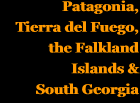 |
||||||||||||||||
 |
||||||||||||||||
 |
||||||||||||||||
 |
||||||||||||||||
Appendix 16 Holiday in the Argentine Lake District and the ascent of Lanín, an excerpt from the diary of A. Tudor Howat (1909-1994) Tuesday 27 December Left Bahía Blanca at 7.30 a.m., Mr Burton and Horace saw me off. After 35 minutes the train suddenly stopped and the engine driver and guards all got out to see what was wrong; after twiddling with the brakes we started off after 20 more minutes. The journey was through very uninteresting flat country sown with wheat, and at every wayside station we saw piles of wheat, bagged ready to go off. Other than wheat there was only scrub — very few trees. It soon grew hot and very dusty, with a strong wind — typical weather. Everything looked parched and dry, but still the wheat went on. There were only a dozen stations between Bahía Blanca and Patagones, and only Stroeder was of any size and that was only a village. It did boast of a Fives-court, though. At one point a hare tried to race the train at the side of the line, and it very nearly kept up with it. We must have been going 35-40 mph and it 30-35 mph. One or two people have asked me if I am going to Bariloche or Chubut — not Patagones, where the train stops. Evidently Patagones is not a place to stop at! We are now in Patagones in the FF.CC.E. train, waiting to go. Not many people travelling. Bought some plums and got 18 for a dozen. So far it has been very hot, very dusty, very windy, but above all enjoyable. 20 kms out we passed a big salina — a large white lake, and round the edge of the water in the middle, it was a beautiful fuchsia colour, due probably to refraction. When we left Patagones, the carriage (Ferrocarril del Estado) was comfortably populated. I had four seats to myself, and the first thing that most inhabitants did was to half undress. And it certainly felt like that, for it got very hot and dusty again. We crossed the Río Negro to Viedma by a new bridge, and then set out on a long monotonous run to San Antonio, the train doing a jogging 40 m.p.h. Occasionally we stopped at a tin hut and a man would get out and disappear over the horizon in an old Ford. Where he went is beyond telling, for besides the stations we can’t have seen more than three other houses between Viedma and San Antonio, just a flat scrub-covered plateau. At San Antonio, there is a small port and quite a number of houses. But the dust! I have never seen anything like it. It surpassed all description — clouds and clouds of it. Leaving San Antonio, we plugged along, up and up, stopping at every little wayside station where peones would be waiting for us. It seemed as if the guard and stationmaster did something in that 20 minutes, such as drink tea, for nothing else was going on. And so on through the night. Wednesday 28 December Next morning it was hillier, but very poor country, no grass, only dry bushy stuff, for they have practically no rain here. During the morning, I palled up with one or two fellow travellers, one going to Bariloche to prospect for oil. Quite an amiable chap. Maquinchao, Jacobacci, Pilcaniyeu. Now for an auto. I had asked one man, who kept a travelling bookstall in the train, about fares to Bariloche and he said he would take me for $15. However, I had suggested to two other men on the train that we should go together, and on leaving it to them to do a bit of bargaining this led to the three of us being taken for $20; so I paid only $7. It was a two hours run over rough roads, through rocky valleys and through one river, before we saw Nahuel Huapi. How beautiful it looked! A huge lake with islands and promontories and surrounded by snow-capped hills, it was a great sight. © The estate of A. Tudor Howat 27-1-2018 |
||||||||||||||||


Main pages
Bariloche line rolling stock •
Com. Rivadavia line extra photos •
Pto. Deseado line extra photos •
Pto. Deseado line extra photos 2 •
Appendices
2 Chronology of Patagonian railway proposals •
3 Bariloche line route itinerary •
4 Com. Rivadavia route itinerary •
5 Pto. Deseado route itinerary •
7 Com. Rivadavia line loco list •
8 Pto. Deseado line loco list •
15 FCP working timetable instructions 1960 •
16 Report on construction 1912 A •
17 Report on construction 1912 B •
21 President Alcorta address •
23 Purchase of wagons decree •
25 Early Patagonian proposals •
26 Progress to Bariloche 1926 •
28 Restructuring report 1953 •
Chapter 4
The FCE broad gauge network